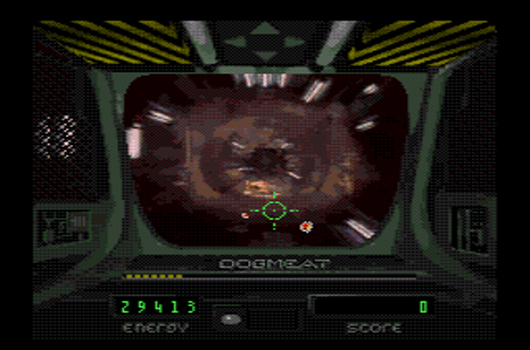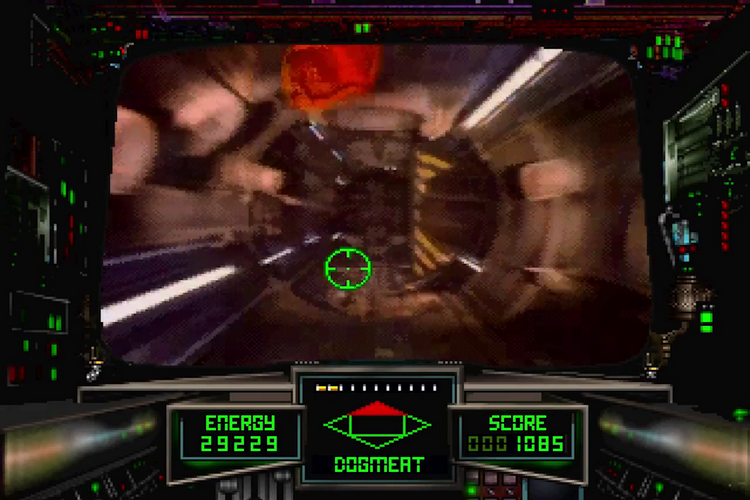Sewer Shark Video Game

| WikiProject Video games | (Rated C-class, Low-importance) | ||||||||||||||||||
|---|---|---|---|---|---|---|---|---|---|---|---|---|---|---|---|---|---|---|---|
| |||||||||||||||||||
Today's entry is Sewer Shark, an early. Sewer Shark for Sega-CD. Touted as 'being large enough to hold every video game released for a. Sewer Shark is a Sega Mega-CD game. It relies heavily on full motion video. The game was a launch title in North America, and later on in the console's lifespan.
References[edit]
Article lacks a references section. Information on 'Production' section especially, while I personally find it interesting, desperately needs citing sources (see WP:NOR).
Sewer Shark was NOT one of the Sega CD's best selling games![edit]
The only reason that so many copies exist is that one model of the Sega CD came with this game. I don't know where the author of the article is getting the idea that it was a hot item. His source only supports that the game was a pack-in title, NOT THAT IT WAS POPULAR. I lived in six different US States during the lifetime of the Sega CD and most people that I knew with a Sega CD bought the system to play Final Fight and role playing games and used Sewer Shark as a soda pop coaster.184.88.80.1 (talk) 05:46, 31 October 2017 (UTC)
- The claim is accurate, in terms of copies sold. Copies sold include pack-ins, and this is consistent with all other console and game articles that deal with pack-ins. If you have a reliable source that states otherwise, please feel free to cite from it in the article. Personal experiences and 'I saw lots of people doing X' are not considered reliable sources. Also, the claim is 'best-selling', not 'most popular' - the term 'best-selling' is verifiable through sales figures. 'Most popular' would be much more difficult to verify because there were very few game-rating sites or publications in existence at the time, and no formal polls for us to draw on. There is one subjective review cited, but that's it, and the claim made in this article is consistent with what the review says (namely, we simply mention what that publication said about it). — KieferSkunk (talk) — 01:20, 3 November 2017 (UTC)
- Looking back on the citation, though, you do have a point. The sales figures for games on the Sega CD and Mega-CD are nearly nonexistent, so there's a lot of speculation out there as to which games were the most popular. We probably do need to remove the 'best-selling' bit and just refer to it as a pack-in title, along with the '100,000 copies' bit. Beyond that, this information is nearly unverifiable. Thanks for pointing out the discrepancy. — KieferSkunk (talk) — 01:31, 3 November 2017 (UTC)
Explanation of recent edits to Production section[edit]
I am the son of the lead programmer on Sewer Shark (and my name is in the Sega CD credits as a tester). As such, I'm a bit more familiar with the development details of this game than most, but unfortunately there are very few reliable sources for most of that info. Unfortunately, game development at the time, and especially in the field of FMV games, was not nearly as well-covered as it is now, so most of the details that are generally relevant to articles like this one are stuck in the heads of people like me. Also, since I don't really have a good place to put this info where it could be used as any sort of citation, I figured I'd put it here. (If anyone from a reputable gaming site wants to interview me, I'd be happy to, but so far nobody's asked. :))
Anyway, I just wanted to explain in a little more depth what my edits are about, in case they help people find references that I haven't been able to track down myself. :)
- Sega CD FMV games were generally criticized for having really small, choppy and grainy video. This is especially true of Sewer Shark and Night Trap because they not only had to compress full-motion, live-action video into 32 or 64 colors, but they had to handle multiple video streams simultaneously (4 for Sewer Shark, 6 for Night Trap if memory serves). A later Digital Pictures game, Prize Fighter, uses the same video codec (which had been improved somewhat by then), but features an introduction sequence with a significantly larger and higher-quality video stream. I believe the main reason for the improvement is that there's only one actual stream being read in a non-interactive sequence.

- The multi-stream format was essentially a holdover from the earlier NEMO VHS format, which interleaved multiple tracks of video one frame at a time (frame 1 had track 1, frame 2 had track 2, etc., until frame 5 was back on track 1, and so on). The NEMO hardware would show the correct frame to the display and ignore the rest, providing a view of just one track at a time - the game software knew how to 'switch tracks' by changing which frame was displayed at a given time, thus making simple linear branching possible.
- There were multiple factors involved in the decision to adapt this 'multiple-stream' format to the Sega CD version, mostly related to the Genesis/Sega CD hardware. The CD drive is only capable of reading data at about 150 KB per second (single-speed) and has slow seek times compared to the faster CD-ROM drives in PCs and later consoles. As such, storing each video clip as a separate file was technically infeasible - it would have been impossible to stream the video smoothly and seamlessly due to the seek times. Additionally, the console has only enough memory to buffer about 2-3 frames of video. At the time, selecting a frame from a set of four in a continuous stream made the most sense.
- A previous version of this section claimed that the custom Digital Pictures codec was similar to the MPEG codec standard. (I might have written that at one time, actually.) There is no official connection between the two that I'm aware of, so I removed that bit. The codec was built mostly as a tile compressor, with a very limited motion-tracking component. I don't have all the details of that system, but I know my father spent months tweaking and optimizing that thing and re-encoding the video dozens of times to try to get it to stream smoothly.
- The original NEMO prototype of Sewer Shark had Catfish continuing to give directions in the second half of the game (these now came 5 at a time instead of 3). I believe, but cannot confirm, that the 'Crazy-lookin' thing' was intended to show up later in that segment, and Catfish was then relegated to just clearing hydrogen pockets. My understanding is that the Sega CD version ended up cutting Catfish's directions and having the bird-thing guide the player right from the start, mainly because the video in this section required more of the console's resources to decode and they couldn't spare the cycles for Catfish's audio clips.
- Similarly, in the NEMO version, Ghost would frequently chime in with brief snippets of praise or criticism ('Great flyin', ace!', 'You're off course!', 'Shoot something, pencilneck!', etc.) - in fact, the tape had digital audio tracks throughout the whole game with random positive and negative statements. Only a few of these were included at the start of the game in the CD version - the rest were cut both to save on computing resources and overall data size - to stream these along with the multi-stream video would have required more bandwidth than the console had. (This is also the reason why you only hear the original background 'tube-flying' sounds when Ghost is talking.)
I'm sure there are more production details I'm forgetting. Hope some of this helps. — KieferSkunk (talk) — 06:50, 23 January 2013 (UTC)
Do you have the guts to take on the sewers and blow away the rati-gators and other nasties lurking below a major corporation? If your answer is yes, then Sewer Shark is your game! As one of the first Genesis CD-ROM releases, Sewer Shark takes you on a high-speed trip through the underground works of a city's sewer system! It's a messy job, but someone has to do it! Piloting your Hole Hog sewercraft, you and your veteran backseat co-pilot, Ghost, must maneuver through twisting tunnels!
Another co-pilot, the mechanical Catfish, speeds ahead of you, scouting targets! The objective is simple: blow away the rodents and follow the directions Catfish gives you.
If you fail to follow them to the letter, you'll hit a dead end! Crash and burn! Watch the arrows at the top of the console -they show you which route to take. Also watch your Energy Level which displays available ammunition. If you run out, you get to do some quick maneuvering while prime targets pass you by!So, do you think you have what it takes to face this disgusting menace?
These additions are noticeable and it is different from the user interface and new graphics. Another great racing game is for download. It also has controllable slider for the sake of mechanical failure. Nascar racing 4 torrent. The Next Level in the Career ModeFree PC NASCAR Heat 4 Game has been adding incrementally to the series career mode in different ways.
Then listen to your co-pilot and 'pretend it's just a game!'
Should satisfy all but the most demanding LEGO-nerd. Ascending and DescendingThe same illusion can be pulled off by cleverly photographing a carefully built sculpture. From most angles such a structure will look like nonsense, but if viewed from just the right position, the faults are hidden and the impossible apparently created.An extraordinary example of this is provided by Andrew Lipson, a self proclaimed nerd, mathematician, and computer programmer, who, along with Daniel Shiu, built a rendition of Ascending and Descending out of the ever-popular LEGO toy bricks. Infinite stairs trick. Descriptions of some of the pieces used to build the model as well as many photographs of the work-in-progress are provided and help explain just how Lipson and Shiu achieved the illusion.Many other people have built and photographed their own impossible Staircases; and, while true Penrose Staircases cannot function in the real world, we see that three-dimensional representations can be tricked into being.And, of course, through clever camerawork Christopher Nolan is able to put a Penrose Staircase on the big screen. By distorting perspective in the two dimensional illustration, the impossibility of the Staircase is removed, and it often takes new viewers a little time to realize that something is not quite right.